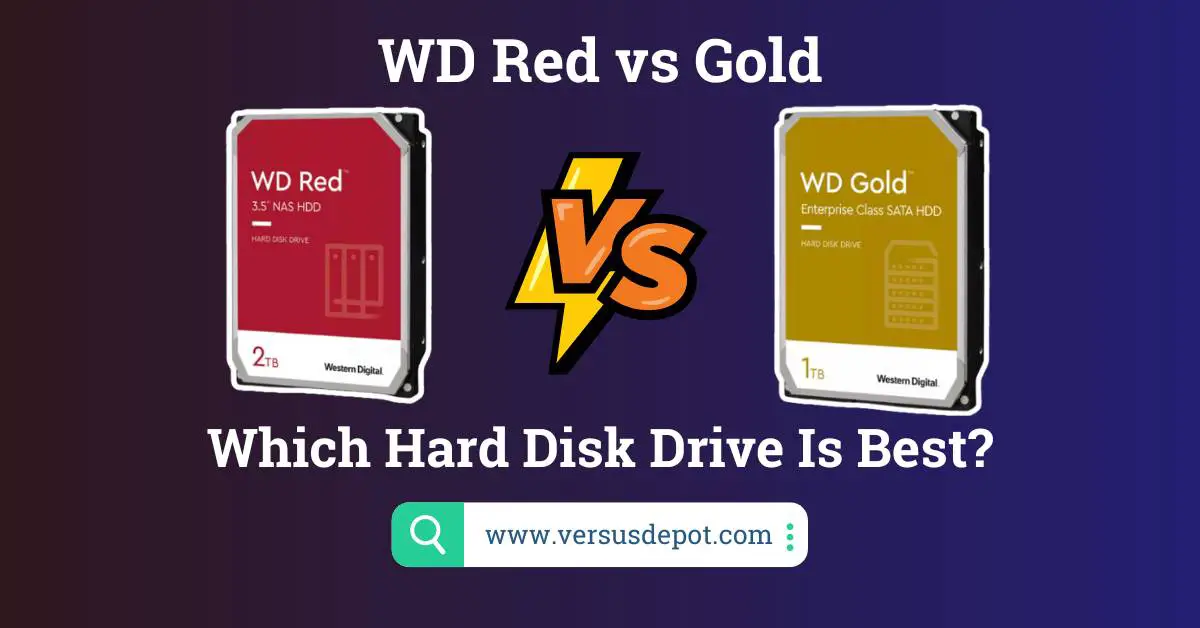This WD Red vs gold comparison is going to discuss all the similarities and differences between these two popular hard disk series. Western Digital is a reputed and reliable Hard Disk Drive as well as Solid State Drive manufacturer in the world. WD Red and WD Gold are two of their most popular Hard Disk Series. These two series come with different features and functionalities that make them suitable for dedicated usages purpose.
So, what are the differences between WD Red vs Gold, and which one is best between them? There are several factors that set these two series apart from each other. The gold series comes with 7200 RPM, while the RED series features 5400 RPM. The GOLD series also outperform the RED series in terms of Storage Selection and MTBF. On the other hand, the RED series has more energy efficient than the GOLD series.
Depending on all these features, WD Gold outperforms WD RED for specific useability. So, what is WD gold best for, and when should you choose WD Red? Continue browsing this article and get a perfect idea and then invest in the perfect one that matches your demand.
WD Red SATA HDD Overview
The first truly specialty HDD for the marketplace was the WD Red series from Western Digital. For interoperability in NAS settings, the WD Red hard disk drive has undergone rigorous testing. You NEED to move to a RAID arrangement, and you’ll need the WD Red NAS disks if you’re worried about losing data because of failing hard drives.
Western Digital’s Red series hard disk drive comes with four storage options; 2 TB, 3 TB, 4 TB, and 6 TB. All these versions feature 3.5 inches as well as 2.5 inches form factor and have an RPM of 5400. Storage with 5400 RPM is less expensive as well as the best way to go through to store a lot of resources.

As opposed to standard hard drives, WD red has less vibration and noise, NASware 3.0 innovation built-in, and error recovery features in case something goes wrong. However, this type of hard disk is not good for installing and running an operating system since they offer a relatively slow data transfer rate than a 7200 RPM Hard Disk.
WD Red drives are made to easily exchange files in your home office or personal space. The innovative technology of Built-in NASware 3.0 increases compatibility, connectivity, upgradeability, and reliability while enhancing storage performance for your system. It allows the NAS to use power more efficiently and safeguards data in the case of a power outage or other disturbance.
WD Gold SATA HDD Overview
WD gold is another best Western Digital hard disk drive series. It is one of the high-performing HDD series among other WD hard disks. WD gold HDDs are available in a lot of storage options to choose from. Western Digital gold is a SATA HDD series that comes with 7200 RPM.
Small- to medium-sized corporate servers are among the demanding use scenarios for which the gold series HDDs are intended. The MTBF of these HDDs is 2.5 million hours, and they can manage workloads of up to 550TB annually. Additionally, it makes use of HelioSeal helium innovation, which boosts the performance of the HDD.

According to WD, Gold’s performance can enhance sequential performance by up to 18% more than the previous version. In order to increase positional precision over the data tracks, it is also equipped with dual actuator innovation, a head positioning device with two actuators.
WD gold series HDDs have different cache memory ranging from 128 to 512 MB based on the storage space. They also offer excellent data transfer speed. WD Gold HDDs are widely compatible with the main corporate operating systems and were created specifically for use in business-grade storage systems and also data centers.
WD Red vs Gold Comparison
Here in this section, I’m going to compare all the basic things of these two popular hard disk drives. I’ll highlight all the similarities and differences between WD Red vs Gold. So, let’s take a look at this comparison and know the similarities and differences between them.
| Hard Disk Drive | WD Red HDDs | WD Gold HDDs |
| Form Factor | 2.5 and 3.5 Inches | 3.5 Inches |
| Interface | Serial ATA | Serial ATA |
| Connection | SATA | SATA |
| Storage | 2 to 6 TB | 1 to 22 TB |
| RPM | 5400 RPM | 7200 RPM |
| Cache | 256 MB | 128 to 512 MB |
| Transfer Rate | 128 MB/s | 269 MB/s |
| MTBF | 1 million hours | 2.5 million hours. |
| Power Consumption | 4.8W | 7W |
| Temperature range | 0-65 degrees | 5-60 degrees |
| Price | Check Price | Check Price |
Form Factor
The first thing to do when looking for hard drives is to determine their form factor. The dimensions of the hard disk and its method of connection to your computer are, in simplest terms, the form factor. The location and configuration of the interface connection, as well as the length, breadth, and height possibilities for HDDs, are all governed by industry standards.
HDDs are available in two form factors; 2.5 inches and 3.5 inches. The platter’s size within the drive enclosures is approximately represented by the 2.5-inch as well as 3.5-inch measures. 2.5 inches HDDs are mostly used in laptops, and desktop configurations use 3.5 inches HDDs.
WD Red hard disk drives are available in both 2.5 inches, and 3.5 inches form factors. That means you can use WD red HDDs on your laptop device. On the other hand, WD gold HDDs are only available in 3.5 inches form factors. That means WD gold is only for desktop computers or server configurations.
HDD Interface
Do you know what is the terms “interface” refers to in terms of storage selection? The component that connects the hard drive to the computer system is called the hard disk interface. Its job is to transfer data between the CPU memory and the HDD cache. The speed at which data is sent between a hard drive and a computer depends on the HDD interface.
HDDs are available in different interface selections, including SATA, PATA, IDE, SAS etc. However, most HDD drives are available in the SATA interface nowadays. Both these Western Digital HDDs come with a SATA interface. The SATA interface makes it simple to connect a hard disk to a computer system.
Transfer Speeds
The rate at which data may be sent between devices is known as the transfer speed. It is also referred to as the transfer rate sometimes. A device’s transmission rate is frequently stated in Kilobits as well as Megabits, which are also simplified as Kbps as well as Mbps, correspondingly.
In terms of Transfer Speed, WD gold outperforms WD red. YES! Western Digital Gold series hard disk drive comes with a faster transfer rate than the Western Digital Red series. WD GOLD Series features up to 269MB/s transfer speed while the RED series has only up to 180MB/s transfer rate. That implies the GOLD series is around 90 MB/s faster than RED Series.
Storage Capacity
Hard drive storage is typically referred to as “disk space” as well as “storage.” Usually, files of all kinds are kept on hard drives for lengthy periods of time. Larger and more complex items, including papers, music, images, and video, may be stored on hard drives with a higher storage capacity. That means the more storage space you have, the more resource you can store.
Both WD red and WD gold hard drive has multiple storage options. Western Digital Red HDDs come with 2 TB, 3 TB, 4 TB and 6 TB of storage options. On the other hand, WD Gold HDDs come with 1 TB, 2 TB, 3 TB, 4 TB, 6 TB, 8 TB, 10 TB, 12 TB, 14 TB, 16 TB, 18 TB, 20 TB and 22 TB storage space.
RPM Selection
RPM counts the number of times the HDD platter of a computer makes a rotation in a minute. The speed at which the data is accessible depends on the RPM. For instance, when comparing two HDDs, one with a 5400 RPM and the other with a 7200 RPM, the latter can access data significantly more quickly.
All the RED series HDDs feature an RPM of 5400. This type of HDD is not a great option to run a system or boot an operating system. However, they are a great option for building low-power servers. On the other hand, Gold series HDDs have 7200 RPM. People searching for huge data, better performance, as well as faster speed should choose these hard drives.
Power Consumption
A hard disk will be deemed more power-efficient if it uses less power. The amount of heat produced increases with much more electricity or energy use. As a result, your laptop or computer will halt more frequently and use more energy, increasing your power cost.
In this case, WD Gold uses more energy than its rival during both the operating and idle phases. It will be considered to be below its rival in this category. While WD Red consumes 4.8W electricity, the Gold series consumes 7W. Given this, WD Red is regarded as a harder drive that uses less energy.
HDD Temperature
One of the main elements affecting the durability of hard disks is temperature. Numerous studies linking disk rate of failure to operation temperature have been conducted throughout the years. Every HDD has an operational temperature range, and the closer it gets to that range, the more likely it is that the disk will fail.
The range of temperature for all WD Gold drives is 5 to 60 degrees, but WD Red drives have varied temperatures for drives based on size. A 2TB hard drive’s temperature range is 0-65 degrees, whereas that of 4TB and 6TB is 0-60 degrees. Red will undoubtedly be rated a little higher than its rival in this area since it has a wider temp range than its competitor.
Cache Memory
The disk buffer is another name for the hard drive cache. By that designation, its intended use is reduced to a little trick. While the HDD reads and writes resources or data to the storage on the platters, it functions like a temporary memory area. A drive’s cache capacity determines how quickly the system can operate.
In fact, a system with an HDD that has a lot of cache memory will run faster than a system with HDD that has less cache. However, if you think about WD Red vs Gold HDD, they both come with good enough cache memory. All the WD red series HDDs feature 256 MB cache memory. On the other hand, the cache memory of the Gold Series may vary between 128 MB to 512 MB based on the storage capacity.
Overall Reliability
Every time we discuss a hard drive’s [HDD] reliability, we take into account its MTBF value. The MTBF value is obtained by subtracting the number of breakdowns from the total operating hours. It simply refers to the average amount of time between system faults and breakdowns.
The HDD will be considered more reliable with a higher value of MTBF. MTBF for WD Red is up to 1 million hours, whereas MTBF for WD Gold is up to 2.5 million hours. As a result, WD Gold HDDs will be judged to be more trustworthy than their rivals and will thus win this category.
The FAQs
What are WD Red drives used for?
For NAS systems in homes and small enterprises, WD Red hard disk drives are the best option. They perform well for sharing and storing backup copies of files, supporting up to eight drive bays as well as 180 TB of workload annually. The main NAS providers approved us after we underwent thorough testing for this kind of operation.
How long do WD Gold drives last?
The WD Gold HDD series of enterprise drives for data centers are a welcome addition to the company’s enterprise drive offering. This powerful HDD has a remarkable MTBF of 2.5 million hours and also can sustain up to 550TB per year in continuous use.
Is WD Red Plus better than WD Red?
If you are using your NAS at home, get a WD Red. If you utilize a NAS in a small to medium-sized business, go with the WD Red Plus. For large businesses looking for a strong business NAS, the Red Pro is one of the ideal options. WD red is the most affordable option than WD red Pro or Plus.
Are higher RPM hard drives better?
The data or resources will be accessible more quickly with the higher the RPM. When comparing, for instance, two hard drives—one with a 5400 RPM and the other with a 7200 RPM—the 7200 RPM hard drive accesses data significantly more quickly than the other. Modern computers without RPM have SSD, which do not have any moving components.
Wrap Up
In conclusion, now you may determine the similarities as well as the differences between WD Red vs Gold hard disk drives. Both these two are high-performing hard disks powered by Western Digital. They come with different storage options and offer different functionalities. Both devices are able to share and store big files of papers, pictures, software, and other things.
However, WD gold HDDs outperform the WD Red series in terms of overall performance. Gold series features faster transfer speed, more RPM, much more MTBF and more cache storage selection. However, they are relatively more expensive than WD Red Series. So, you can choose any of them depending on your budget and uses purpose.





